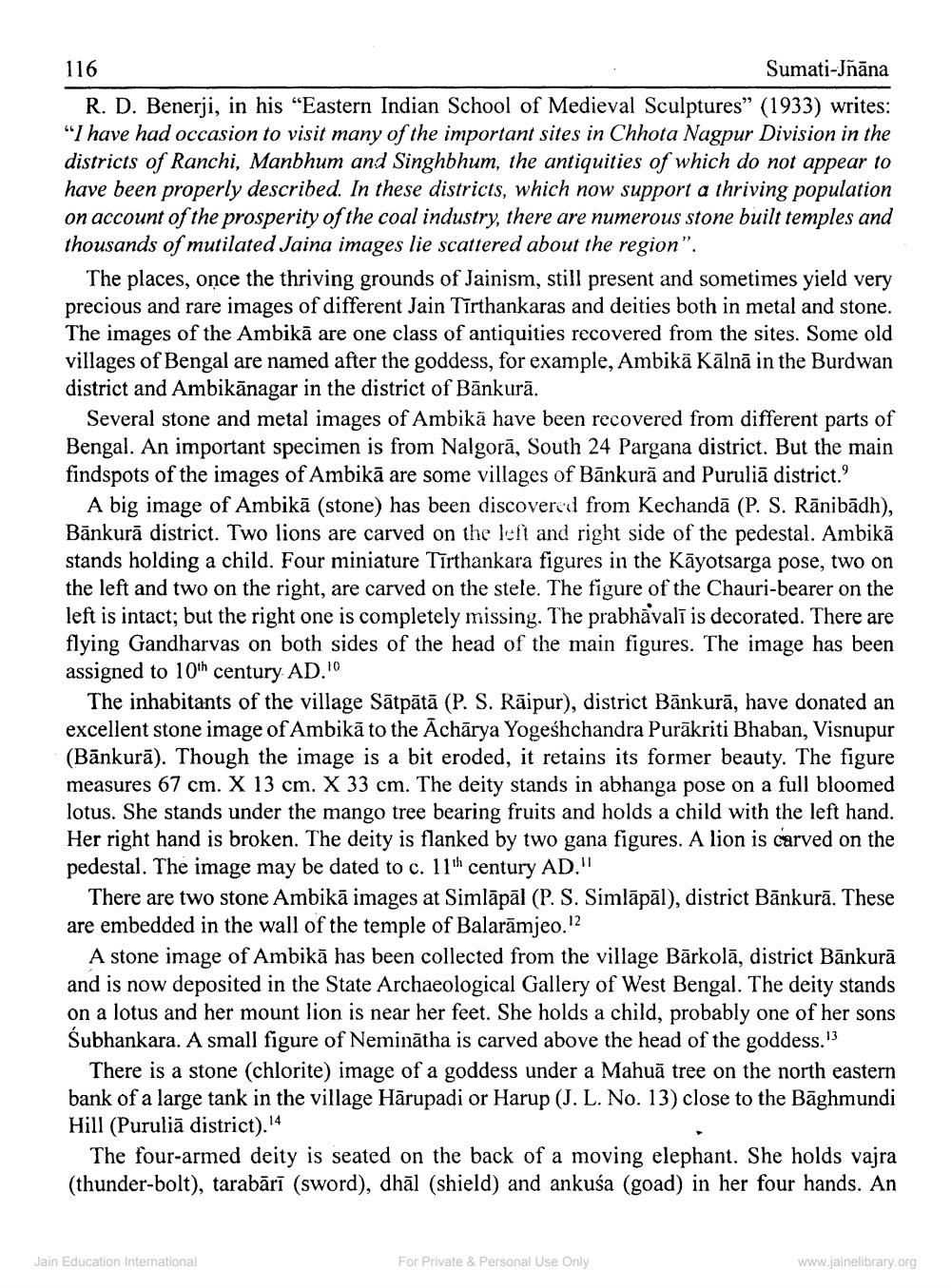________________
116
Sumati-Jñāna
R. D. Benerji, in his "Eastern Indian School of Medieval Sculptures" (1933) writes: "I have had occasion to visit many of the important sites in Chhota Nagpur Division in the districts of Ranchi, Manbhum and Singhbhum, the antiquities of which do not appear to have been properly described. In these districts, which now support a thriving population on account of the prosperity of the coal industry, there are numerous stone built temples and thousands of mutilated Jaina images lie scattered about the region".
The places, once the thriving grounds of Jainism, still present and sometimes yield very precious and rare images of different Jain Tirthankaras and deities both in metal and stone. The images of the Ambika are one class of antiquities recovered from the sites. Some old villages of Bengal are named after the goddess, for example, Ambikā Kālnā in the Burdwan district and Ambikanagar in the district of Bänkurā.
Several stone and metal images of Ambikä have been recovered from different parts of Bengal. An important specimen is from Nalgora, South 24 Pargana district. But the main findspots of the images of Ambika are some villages of Bankura and Purulia district.'
A big image of Ambikā (stone) has been discovered from Kechandā (P. S. Rānibādh), Bānkurā district. Two lions are carved on the left and right side of the pedestal. Ambikā stands holding a child. Four miniature Tīrthankara figures in the Kayotsarga pose, two on the left and two on the right, are carved on the stele. The figure of the Chauri-bearer on the left is intact; but the right one is completely missing. The prabhavali is decorated. There are flying Gandharvas on both sides of the head of the main figures. The image has been assigned to 10th century AD.10
The inhabitants of the village Sātpātā (P. S. Rāipur), district Bānkurā, have donated an excellent stone image of Ambika to the Acharya Yogeshchandra Purakriti Bhaban, Visnupur (Bānkurā). Though the image is a bit eroded, it retains its former beauty. The figure measures 67 cm. X 13 cm. X 33 cm. The deity stands in abhanga pose on a full bloomed lotus. She stands under the mango tree bearing fruits and holds a child with the left hand. Her right hand is broken. The deity is flanked by two gana figures. A lion is carved on the pedestal. The image may be dated to c. 11th century AD."
There are two stone Ambikā images at Simlāpāl (P. S. Simlāpāl), district Bankura. These are embedded in the wall of the temple of Balaramjeo. 12
A stone image of Ambika has been collected from the village Bārkolā, district Bankura and is now deposited in the State Archaeological Gallery of West Bengal. The deity stands on a lotus and her mount lion is near her feet. She holds a child, probably one of her sons Subhankara. A small figure of Neminatha is carved above the head of the goddess.13
There is a stone (chlorite) image of a goddess under a Mahua tree on the north eastern bank of a large tank in the village Hārupadi or Harup (J. L. No. 13) close to the Baghmundi Hill (Purulia district).14
The four-armed deity is seated on the back of a moving elephant. She holds vajra (thunder-bolt), tarabārī (sword), dhal (shield) and ankuśa (goad) in her four hands. An
Jain Education International
For Private & Personal Use Only
www.jainelibrary.org




